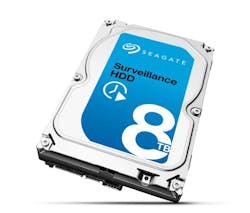Seagate adapts to meet the needs of a changing video storage marketplace
With the proliferation of high-definition video surveillance cameras across both the public and private sector in recent years, there has been an increased burden placed on backend storage infrastructures to retain a greater amount of data. Many end users have reached a point of critical mass with their onsite surveillance storage solutions and are now looking for a cost-effective means of holding on to this video footage, whether it be through adding commercial-off-the-shelf hard drives to their server racks to accommodate the need for increased storage capacity or by offloading some of the data to the cloud. However, with the deployment of traditional and body-worn cameras expected to rise, storage demand are only going to increase exponentially and organizations will need to allocate resources for the installation of purpose-built storage solutions.
In an effort to meet evolving market demand, Seagate recently unveiled a new 8-terabyte hard disk drive specifically tailored for surveillance applications. Engineered to run 24/7, the drive can store over 800 hours of high-definition content captured by up to 64 cameras simultaneously recording HD content.
According to Aubrey Muhlach, surveillance segment marketing manager for Seagate, a single camera recording at a resolution of 1080p at a rate of 15 frames-per-second is generating 45 gigabytes of data every day. If you consider the fact that IT and security systems integrators in a recent survey reported that the median number of cameras installed per installation is 250, that’s slightly more than 11 terabytes of data being recording daily and those customers are storing data in most cases for at least 30 days, meaning that over 330 terabytes of footage is being retained each month. That same study also found that beyond 60 days, the reason most people stopped recording was because they didn’t have enough storage space to back it up.
“If we look at that in terms of the number of drives that you need to support that, today the highest capacity shipping for the surveillance market is a 6-terabyte drive, so we would need about 57 drives to hold all of that data just for 30 days,” said Muhlach. “If we go to 8 terabytes, that will help alleviate the pain a little bit and bring us down to 43 drives. If you’re that integrator or installer working in a tight, very confined footprint, this will give you some opportunity to expand and get the higher capacities into that system.”
The new drive also incorporates rotational vibration sensors which enable it to reliably perform in systems with eight or more drives.
“We added that to make sure that as we’re going into these larger NVR applications that we can tolerate the vibration from other drives within that specific application and to make sure we can maintain our performance,” said Muhlach.
Undoubtedly, many people would question the need for a hard disk drive that is surveillance-optimized when they can go out and find a COTS solution that will work just fine. The simple answer, according to Muhlach, is that these drives are not designed to deal with the rigors of surveillance storage.
“That surveillance drive is tailored made for surveillance applications. A desktop drive is literally built for what you hope your workday looks like – start at eight, end at five for five days a week. It’s not built to run all day every day. Desktop drives are built to open up small applications supporting your email and web browsing and, as a result, the workload rating for the total amount of data that’s transferred to a drive in a year reflects that as it is 55 terabytes per year for a desktop-class drive,” explained Muhlach. “When we talk about the surveillance drive, that drive is built to be always on, always recording, 24 hours a day, seven days a week. It’s also built knowing it’s going to have multiple cameras recording in these higher resolutions streaming to it simultaneously during that time. When we built the drive, we improved the drive workload to 180 terabytes per year to make sure the drive could support it. In a nutshell, if you put a desktop drive into a surveillance application – you’re streaming six cameras at 5 Mbps – we would be wearing that drive out, exceeding workload capability in six months.”
That’s not only important from a reliability standpoint for end users; it’s also a key consideration for integrators looking to make a good impression on potential customers.
“In talking with our customers, one of the things we have learned from them is when they’re going in to make a deal with an end user, that’s not the first and only time they’re going to be talking to that end user, so we want to make sure they go in and sell the right solution for today and also for future expansion opportunities,” said Muhlach.
About the Author
Joel Griffin
Editor-in-Chief, SecurityInfoWatch.com
Joel Griffin is the Editor-in-Chief of SecurityInfoWatch.com, a business-to-business news website published by Endeavor Business Media that covers all aspects of the physical security industry. Joel has covered the security industry since May 2008 when he first joined the site as assistant editor. Prior to SecurityInfoWatch, Joel worked as a staff reporter for two years at the Newton Citizen, a daily newspaper located in the suburban Atlanta city of Covington, Ga.

